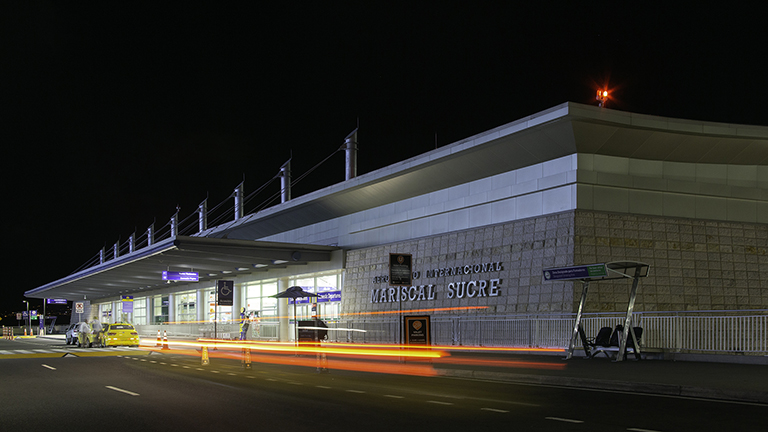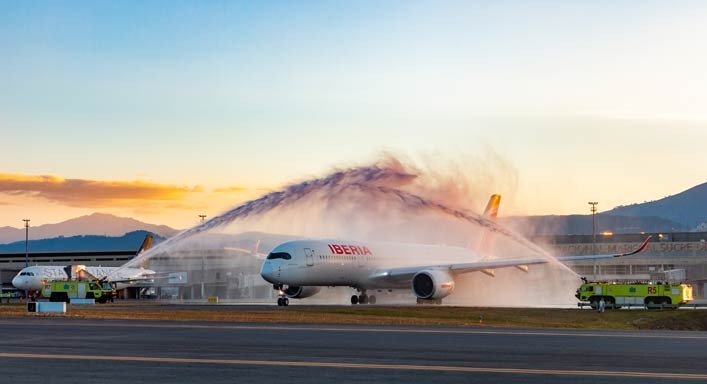Quito airport: one year after the return of operations

- Between June 1, 2020 and May 31, 2021, a total of 1,115,826 passengers moved through the Quito airport.
- 12 international airlines fly to 11 direct destinations from Quito.
As of the first of June, one year has passed since the resumption of commercial passenger operations at Quito’s Mariscal Sucre International Airport, after operations were halted in mid-March 2020 because of the COVID-19 pandemic.
Between June 1, 2020 and May 31, 2021, a total of 1,151,826 passengers transited through the Quito airport on domestic and international departures and arrivals flights. The monthly passenger average during this period was 95,985 passengers, that is, 77% lower than the monthlyaverageregisteredbeforethepandemic(418,614 dailypassengers).
Of the total number of travelers, 592,192 correspond to international flights, while 559,634 were domestic passengers.
The recovery in passenger volume has been gradual, but steady. In June 2020, 19,664 passengers used Quito’s airport and by May 2021, a total of 163,082 people used the air terminal.
In terms of connectivity, approximately 80% of the frequencies with which the airport operated before the pandemic have been restored. Of the 17 direct international destinations that were reached from Quito, 11 have resumed: Amsterdam, Atlanta, Madrid, Fort Lauderdale, Houston, Miami, Mexico City, Panama, San Salvador, Bogotá and Lima.
Similarly, out of 18 international airlines that flew in 2019, 12 carriers are now operating again at the Quito airport.
Regarding domestic traffic, seven destinations have been restored within the country, of the nine that existed before the health crisis: Guayaquil, Baltra, San Cristóbal, Cuenca, Manta, Loja and Coca. Three airlines provide the service of domestic commercial passenger flights.
The road to recovery

In mid-March 2020, the Emergency Operations Committee of Ecuador determined the cessation of commercial passenger air operations throughout the country due to the pandemic caused by COVID-19.
Despite this, the Quito airport never stopped operating; it remained open to handle repatriation flights and also air cargo operations, for both exports and imports.
Soon after, Quiport began an investigation of all the international and national provisions regarding biosafety protocols and began to design the changes that should be implemented to guarantee the health of passengers, users and airport employees.
Sandro Ruiz, general manager of the Metropolitan Public Airport Services Company (EPMSA in Spanish), considers that the role played by the Quito airport during the first months of the pandemic was very important, allowing the return of Ecuadorian nationals and foreigners residing in the country who were abroad. “We served as an international connection hub and, additionally, all logistical support for cargo was always kept operational.”
“The more than 225 outbound repatriation flights that operated in Quito allowed us to mobilize thousands of passengers who wanted to return home. The repatriation operations permitted us to establish the parameters for all the biosecurity protocols so that passengers could travel safely,” recalled Allan Padilla, Director of Operations of Corporación Quiport.
Multiple meetings were held between national authorities, institutions and companies involved in air transport to design the health security protocols at the airport. After developing the protocols, the physical adaptations began to be implemented in the passenger terminal: placement of glass screens at the airline check-in counters and at the migration counters, floor signage to mark the required social distance, reduction of occupancy in departure lounges, restaurants and shops, thermal cameras for measuring body temperature and disinfection mats. Additionally, procedures were established for the disinfection of all passenger transit areas, as well as an information campaign was launched to promote the observance of biosecurity measures at the airport.
Ready to resume operations
 The protocols and procedures were verified by representatives of the National COE, as well as by authorities of the General Directorate of Civil Aviation and the Municipality of Quito who agreed to permit the return of commercial passenger operations as of June 1.
The protocols and procedures were verified by representatives of the National COE, as well as by authorities of the General Directorate of Civil Aviation and the Municipality of Quito who agreed to permit the return of commercial passenger operations as of June 1.
Anyelo Acosta, the highest authority of the General Directorate of Civil Aviation, assures that it was much easier to make decisions because there were plans and protocols, and a manual and biosafety procedures were worked on. “Corporación Quiport made all the necessary adjustments and spared no expense on making changes to adapt to this new reality in aviation. After several meetings and tireless hours of work, we managed to have an airport with the necessary conditions to receive passengers”.
“The decision to resume the commercial activity of passengers at the Quito airport came after a joint analysis with all the main actors of the airport; it was a combined effort between the national government, the local government, and the Quiport concessionaire. We strategically chose the most balanced date from the economic point of view, but also from the biosafety point of view,” remarked Sandro Ruiz.
The president of the Association of Airline Representatives in Ecuador (ARLAE), Marco Subía, highlighted that “the fact that all the industry players have worked together to achieve a prompt reopening of the Quito airport, and of the country in in general, it has helped the industry to reactivate in a better way”.
Regional leadership
In this fashion, Mariscal Sucre airport was the first in the region to resume commercial passenger operations, paving the way for other airports in Latin America to start their own recovery processes.
“The Quito airport was a benchmark in the region. We had several conversations with the International Civil Aviation Organization and with several countries in the region to understand what we did well to keep the airports operational “, revealed Anyelo Acosta, while Marco Subía estimated that” Quito, and Ecuador in general, took a very important initiative and leadership and we are seen as a regional and global marker for what should be done”.
In August 2020, Quito International Airport obtained the Airport Health Accreditation (AHA) granted by the Airports Council International (ACI). The Airport Health Accreditation certifies that the airport complies with the recommendations of the Council of the International Civil Aviation Organization (ICAO) to establish common sanitary measures and is aligned with the best practices of ACI, as well as with the aviation security protocol developed by the European Union Aviation Safety Agency (EASA).
For Ramón Miró, president and CEO of Corporación Quiport, “to return to operating commercial flights in the situation that the country and the world were going through, was undoubtedly a very important challenge, which we assumed aware that our team would work arduously so that the airport operations would be properly managed, adapt to the new reality and above all to gain the trust of our passengers and that they feel safe to travel again”.
“A year later we see the fruits of this effort. We have more and more airlines, more frequencies and more passengers. We continue to reinvent ourselves, adapt and, above all, fulfill our mission and vision as a company”, he concludes.
